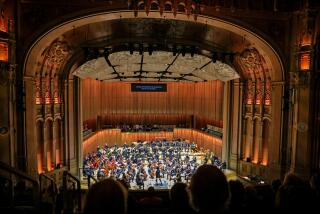MUSIC AND DANCE REVIEWS : Pasadena Symphony in 66th Season
- Share via
Despite the presence of a large and festive audience, tall arches of multicolored balloons outside the auditorium and considerable societal hubbub in the foyer, the opening of the Pasadena Symphony’s 66th season, Saturday night in Pasadena Civic Auditorium, turned out to be a lackluster affair--at least for the first half.
After that, Brahms’ Second Symphony, in a well-limned, carefully balanced and musically unified reading, saved the night. But what had gone before--more or less neatly, usually with close attention to detail from both conductor and players--fell short of both high energy and high inspiration.
Beginning his 10th season with the orchestra, music director Jorge Mester has now brought his ensemble to its next plateau. But some old problems remain. For one, how to prepare a thoughtful, demanding and provocative program in minimal rehearsal time.
The dilemma arose, again, to vex the listener at this opening. Bartok’s challenging “Miraculous Mandarin” suite, which began the evening, is simply too familiar and asks too much in mechanical/technical terms, to be given third place in rehearsal priorities. This performance went along but did not rise above the pedestrian.
Ravel’s Piano Concerto for the Left-Hand, the occasion for the Southland return of the justly admired Mexican pianist, Jorge Federico Osorio, also emerged as respectable. Yet it lacked that optimal concentration, fire and collaboration. Nothing went seriously wrong, yet all parties seemed stranded on the first level of preparation. One would like now to hear the gifted Osorio in a solo recital.
Brahms’ D-major Symphony made the evening worthwhile, in a well-driven but mellow, emotionally resonant performance to which most of the solo chairs--but particularly that occupied by hornist James Thatcher--contributed strongly.
More to Read
The biggest entertainment stories
Get our big stories about Hollywood, film, television, music, arts, culture and more right in your inbox as soon as they publish.
You may occasionally receive promotional content from the Los Angeles Times.










